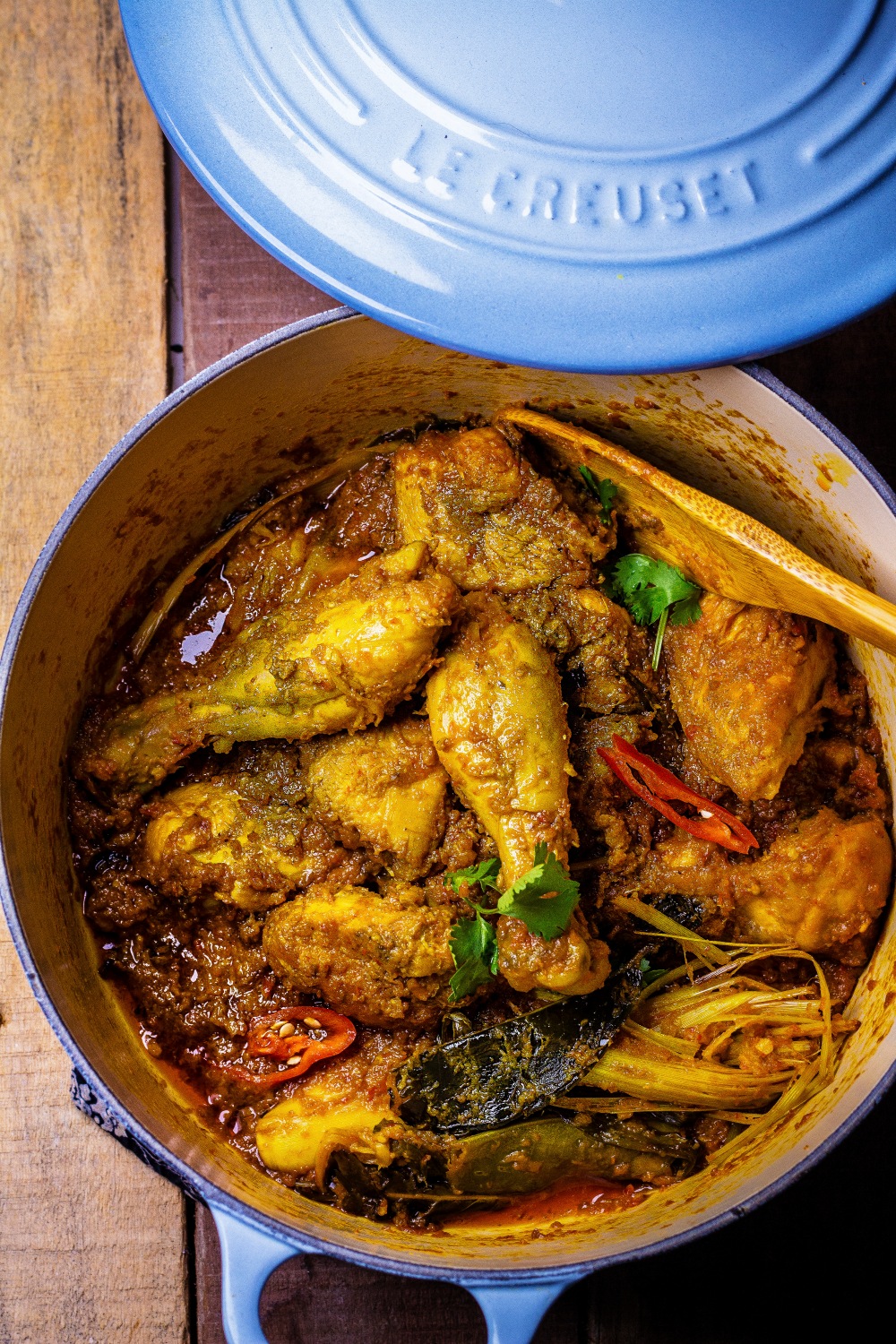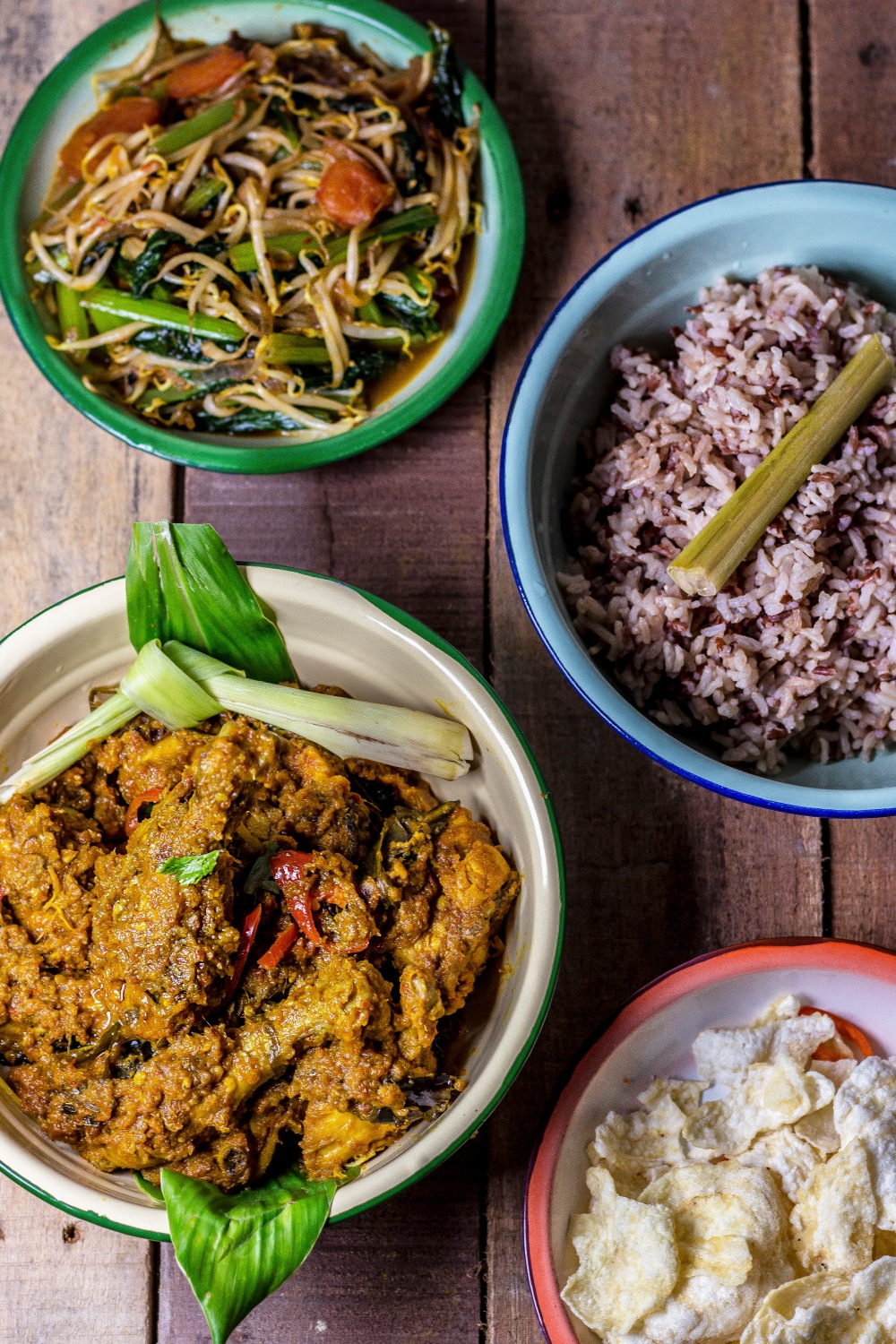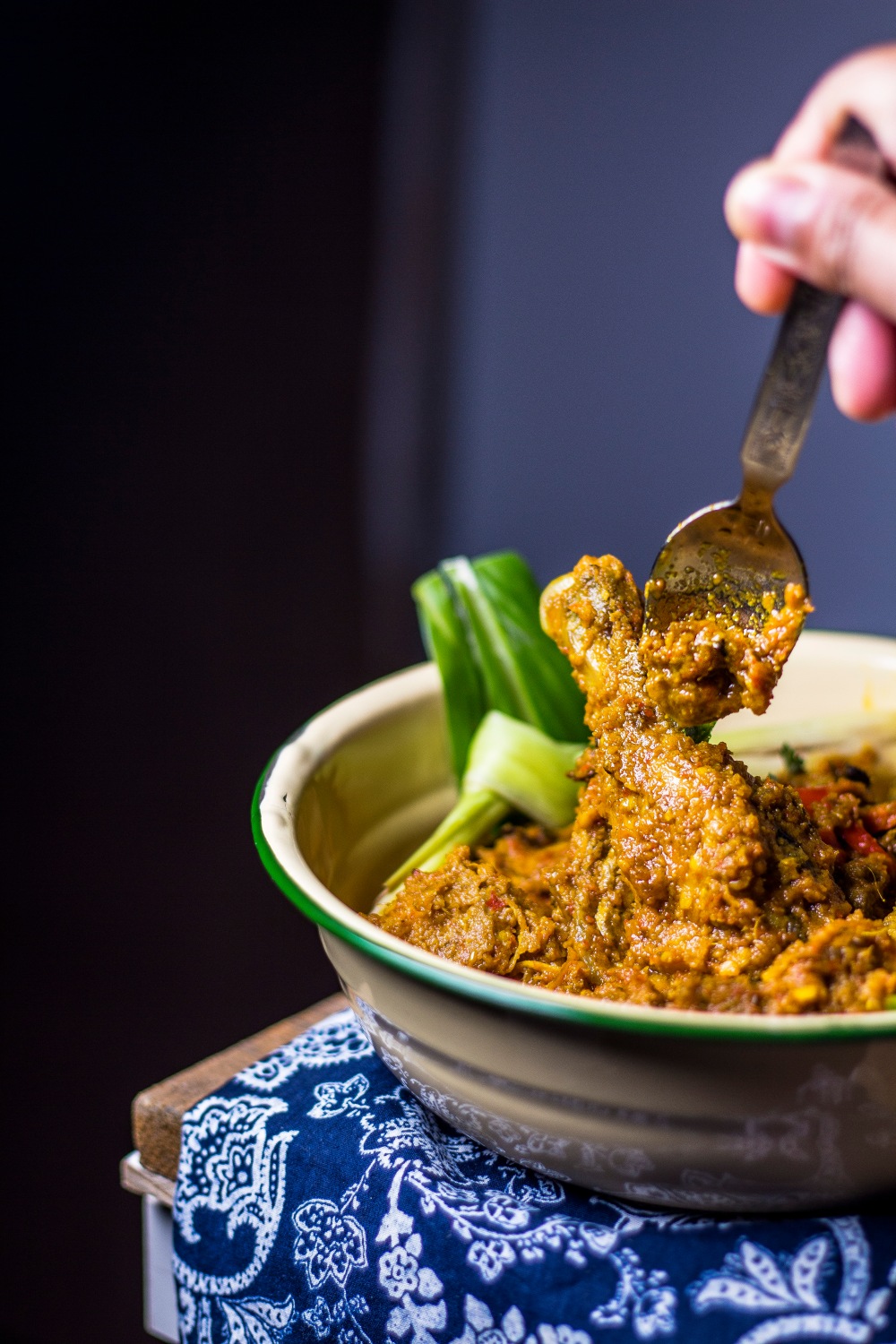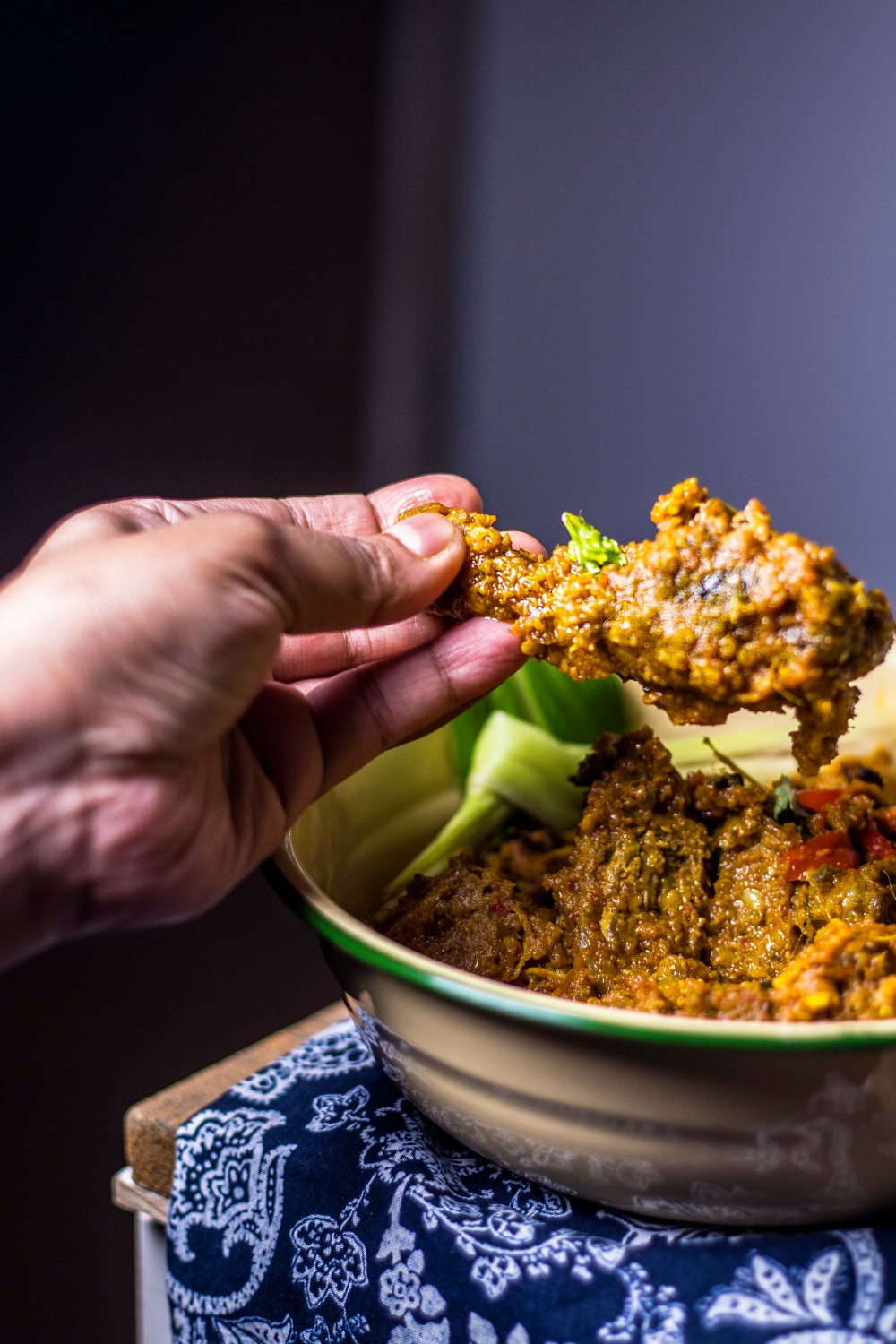
A quick internet search for ‘rendang’ will yield several thousands of recipes for rendang as this is a much loved dish in Indonesia, Malaysia and Singapore. Ancient maritime trade and shared histories have ensured that this dish crossed over from its West Sumatran origins to Malaysia and Singapore. It is not known when this dish originally appeared in the homes of the Minangkabau, the people of Padang, West Sumatra, but what is known is that it is a dish made on special occasions like the end of Ramadan to celebrate the successful end of a month long of fasting.

The terms ‘rendang’ and ‘kalio’ actually refer to the method of cooking rather than the dishes’ names. Rendang is essentially meat, traditionally beef or buffalo, that is slow-cooked in coconut milk and spices until the meat has darkened to dark brown and has absorbed almost all the sauce. Often, kerisek, toasted and ground coconut, is also added at the end of rendang cooking to intensify the caramelised coconut flavour. Kalio, however, is often mislabeled as Rendang and uses the exact recipe as rendang but the cooking process is stopped before all the coconut milk is absorbed by the meat and no kerisek is added. If the sauce is reduced even lesser, than the dish is called a gulai.
Let’s make things easier…
Gulai: More ‘curry’ like sauce, start of oil separation, meat is pale, mild flavoured dish. Great everyday dish.
Kalio: Thick sauce, oil separation is more obvious, meat is slightly browned, rich and good depth of flavour.
Rendang: The sauce is almost completely absorbed and only clinging onto meat, meat is dark and toasted and ground coconut (kerisek) is added at the end. The resulting dish is very rich and a beautiful labour of love.
This was a revelation to me as what distinguishes the three dishes is the depth of flavour attained from the longer cooking rather than the ingredients used. Lean cuts of meat like beef brisket and buffalo would benefit from longer cooking and it would be safe to assume that since meats were much leaner in the past, using the rendang cooking technique to tenderise tough cuts would have made a lot of sense.
However, given that farmed raised chickens are hardly tough, making a rendang was out of the question for me as overcooked, stringy meat is one of my pet peeves. Instead, I prefer a kalio method when cooking chicken and once the meat is cooked, I remove them immediately to stop their cooking and reduce the sauce. But if you have access to good, free-range chicken that can stand up to longer cooking, then by all means continue to reduce the sauce with the chicken pieces in the pot. The length of cooking all depends on the cut and quality of your meat. Also, how thick you want your sauce is entirely up to you. I opted for a really thick sauce that was clinging onto the meat as that was what I felt like eating that day. I get an extra kick out of licking my fingers after eating dishes with thick sauce, like my Lamb Bhuna (a North Indian version of rendang!). A less thick sauce for kalio is completely acceptable if you’d like more gravy for your rice and it is no less delicious than a thicker sauce kalio.

About the recipe’s name
Almost everyone knows what a rendang is but very few know what a kalio is. It was only in my research into Indonesian and Malay cuisine that I learnt that the rendang dishes I’d been eating since young were actually kalio. Hence, I have decided to give a familiar reference point in naming the dish so that many can relate to it. It is in no way meant to be disrespectful to the culinary cultural heritage and significance it has to many Indonesians.
About the ingredients
Coconut milk: The beauty of a kalio and rendang is in the dramatic transformation of coconut milk. The transformation of pale, creamy coconut milk to a burnished brown, nutty sauce is one of the many joys of cooking, in my opinion. Coconut milk is a wonderful carrier of flavour and so it absorbs all the flavours of the herbs and spices and imbues the dish with an otherworldly robe that highlights the best aromas and flavours that southeast asian cuisine has to offer. I use freshly squeezed coconut milk. I let freshly grated coconut milk sit in equal amount of warm water for about 15 minutes. Then, I gather the sodden grated coconut in a muslin cloth and squeeze every ounce of milk there is. This is first pressed coconut milk. If left to stand, the milk will separate into coconut cream and coconut water. When I repeat the warm water treatment and squeeze coconut milk, the coconut extract is known as coconut milk and this is what is commonly used in dishes when it is added after the spice paste is cooked out. However, if fresh coconut milk isn’t available, then tinned or packet coconut milk that has been diluted with equal parts water is a good alternative. Just purchase one without any additives like carrageenan, which is an emulsifier. The addition of carrageenan does not allow the coconut milk to split and your kalio will be very thick and not have enough of an oil separation.
Spice paste: All the spices in the paste are necessary. Store bought rendang paste have nothing on freshly made spice pastes. The spice paste should not be too finely ground – medium coarseness is enough. I use the ‘pulse’ function of my food processor to achieve this. Since the recipe uses chicken, I’ve not used spices with strong aromas like star anise and cloves as they would overpower the delicate herbs, coconut and chicken. Increase the number of red chillies based on your spice tolerance level. I only used 7 red chillies and I’m going to stick with that as I really liked the balance of flavours. Though chillies feature in all kalio and rendang recipes, they are only added to balance the richness of coconut milk and not for their heat.
The rest of the ingredients: Use as many of the herb leaves, salam, turmeric and kaffir, as you can find. Asam gelugor is a mild souring agent that is essential in this dish as the mild tartness really brings the dish together. Use diluted tamarind paste as a substitute. I would not use lemon juice as it tends to curdle fresh coconut milk.



About the Le Creuset Round French Oven pot I’ve used
My preferred cookware for making a fantastic kalio are my Le Creuset pots. As the dish gets its signature flavour from the slow caramelisation of coconut milk, the thick cast iron material that all Le Creuset pots are made of is especially good for this. The heat stays constant and uniform in all Le Creuset pots so your sauce will not burn on one side. Also, the coconut milk caramelises and leaves a thin layer of fond at the bottom of the pot every time it reaches caramelisation point. This thin layer of fond has to be constantly scrapped using a spatula as this is what gives the dish its depth of flavour. The enamel coating on the inside of the Le Creuset pots make it really easy to keep scrapping the bottom. The accumulation of the thin brown layer (a.k.a fond) is perfectly normal and should be expected each time spice pastes are cooked out in oil. The enamel coating also makes cleaning a cinch- just soak the pot in water for about 30 minutes and gently wipe away the brown bits using a sponge. If the food stains are stubborn, let the water come to a boil and using a wooden spatula, slowly scrap away at the food bits. Another perk of my Le Creuset pots is that they never get stained from turmeric! If you cook frequently with turmeric then you should about know the stubborn stains it leaves on your kitchen counter tops. But so far, my pots have remained stain free.
** recipe updated on 5th May 20.
Ayam Kalio (Lazy Man's Chicken Rendang)
Ingredients
To grind into spice paste (bumbu)
- 1 teaspoon coriander seeds, lightly toasted
- 1/2 teaspoon cumin seeds, lightly toasted
- 1 green cardamom, lightly toasted
- 3 candlenuts / macadamia nuts
- 5 garlic cloves
- 10 shallots
- 7-10 fresh spur/long red chillies
- 1 inch ginger root
- 1 inch galagal root
- 1 inch turmeric root
______________________________________
- 1 – 1.2 kilogram chicken, with bone, skin removed
- 1/8- 1/4 cup coconut oil
- 2 lemongrass, bruised and knotted
- 2 salam leaves / Indonesian bay leaves (optional)
- 5 kaffir lime/makrut leaves, crumpled
- 1 large daun kunyit/turmeric leaf, knotted
- 400-500 millilitres coconut milk/ second coconut extract
- 2 dried asam gelugor slices
- 2-3 tablespoons coconut cream / first coconut extract (optional)
- fine sea salt
Method
- Cut chicken into 8-10 medium-sized pieces. Wash thoroughly and marinate with 1 tsp fine sea salt. Set aside for 20 minutes.
- Grind spice paste to medium fineness and set aside.
- In a thick-bottom pot, heat coconut oil and add ground spice paste (bumbu) and lemongrass and salam, kaffir and turmeric leaves. Using a flat-edged spatula/ wooden spoon, constantly toss the spice paste. The paste should not start to catch at the bottom. Constantly scrap all browned bits (fond). Add a splash of water if the paste starts to turn dark brown. If paste has turned very dark brown/ black, restart.
- Once the oil starts to separate, continue frying the paste until it comes together and smells aromatic, about 10-15 minutes from start to oil separation.
- Add marinated chicken, coconut milk and asam gelugor slices. Reduce heat to medium low and continue to gently simmer chicken with pot uncovered.
- Once gravy is reduced , ‘red oil’ starts to separate and chicken is fully cooked, remove only the chicken pieces to a large bowl and set aside. (Gulai stage)
- Continue to reduce the gravy until it is thick and light to reddish brown, about 10-15 minutes. The ‘red oil’ separation will be more obvious. Return cooked chicken pieces to the pot. Add coconut cream for smoothness and richness(optional). Toss chicken in gravy. Check for seasoning. Switch off the heat. Serve warm with plain rice.
- To reheat, in a covered pot, add a splash of water and heat over very low flame until meat is hot.

Thank you for reading my long-winded post 🙂 I have so much I want to share with you because cooking and reading about food such as this is so interesting and enlightening to me. If you’re keen to know more about my sources, do drop me a comment. If not, I won’t bore anymore you with more details. I do hope you give this delectable recipe a go. It is very delicious!
Mmmm. And so beautiful, too!
LikeLiked by 1 person
Thank you!
LikeLike
Thank you so much for the clear explanation on the variance of the cooking style. I could just taste the flavor by just looking at your photo.
LikeLike